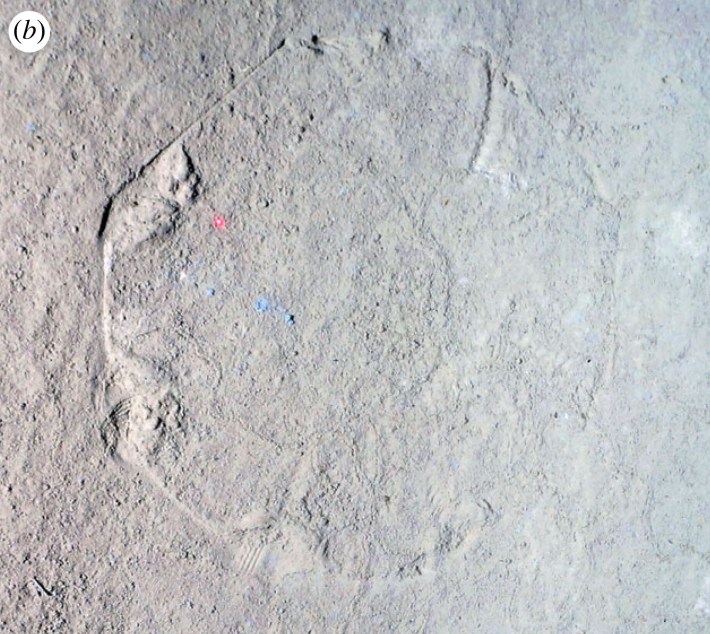The bottom of the Fram Strait, the oceanic passage between Greenland and Svalbard, is, like any other seafloor, a mostly nondescript blanket of sludge. But the Fram Strait seafloor is decorated by octagons of various sizes, some as small as Oreos and others as big as extra-large pizzas. These octagons erratically polka-dot the muddy seafloor, as deep as 14,000 feet below the surface. When scientists on a research cruise dragged an underwater camera above the seafloor, they observed 106 of these octagons, some clustered close together and others in total isolation.
Although too frigid, dark, and wet for our tastes, the deep ocean floor is an ideal home for many creatures, many of whom leave behind particular footprints in the sludge (I use footprints metaphorically, as the deep sea is generally devoid of feet). Unlike shallower waters, the deep sea experiences very little water movement that would bury these traces, leaving ghostly imprints across the abyss. King crabs leave trails of puncture marks. Gummy squirrels, a species of sea cucumber, leave wandering imprints of their squishy walking appendages. Unavoidably phallic acorn worms excrete poop tubes that spiral like funnel cakes. And though coils of poop tubes are certainly exciting, all these traces look obviously animal-made and therefore less eerie when we inevitably discover them.

Whenever a deep sea creature leaves a trace that is more orderly and geometric, people freak out. Consider the lawful line of holes found in waters north of the Azores, the creator(s) of which are still at large. But the white-spotted pufferfish's extraordinarily symmetric mandalas should be proof enough that creatures are capable of geometry. And the octagonal nature of these prints point to an obvious, eight-armed creator. In a paper published in the journal Proceedings of the Royal Society B, scientists suggest that the cirrate octopus Cirroteuthis muelleri plunges to the seafloor to feed, and in doing so, leaves behind charming octagonal imprints in the silt.
Cirrate octopuses, one of the two main types of octopus, live in the deep seas across the world. They are inkless, gelatinous, and immediately recognizable by a large pair of lop-eared fins on their heads, hence the nickname "dumbo" octopus for certain species. C. muelleri, the only octopus currently known from the Arctic Ocean, are most often seen motionless and drifting, in the open water, sometimes less than 2,000 feet from the surface. But prior studies of the stomach contents of wild C. muelleri octopuses only contained bottom-dwelling prey, such as crustaceans, suggesting they fed on the seafloor.
On recent deep-sea surveys in the Arctic, the authors of the paper observed a handful of octopuses descending from the water column to the seafloor, seemingly to hunt. The octopuses all repeated the same sequence of movements. First they swim slowly just above the seafloor with their arms curved to be parallel with the ground. They spread their webbed arms out and envelope the ground below them. They rotate their fins, presumably to suck out whatever prey might be between them and the seafloor, and sometimes flap their fins faster. And finally they take off from the seafloor to return to open water.
The researchers argue this repeated behavior must represent feeding. They suggest these octopuses are simply not capable of capturing engulfing prey in the water column, as their suckers are too weak and they move too slowly to their fast-moving prey. In one video, the researchers observed some mucus and perhaps the remains of prey falling from the octopus after a descent. And the octopuses did not appear to be startled by the ROV; some even curiously approached the cameras.
Although this is the first report of cephalopods migrating from the water column to the seafloor to hunt, scientists have observed this behavior in some deep-sea gelatinous fish and swimming sea cucumbers. It's a pretty good strategy, one that allows animals to avoid predators and save energy by drifting on ocean currents. These observations of C. mueller add a crucial third perk to this strategy: style, and pizzazz.
Scientists are still learning how deep-sea environments are intimately connected, and there's no better proof than an octopus drifting miles to the very bottom of the abyss for a spot of lunch. Think about that the next time you complain a restaurant is "too far away to walk."






